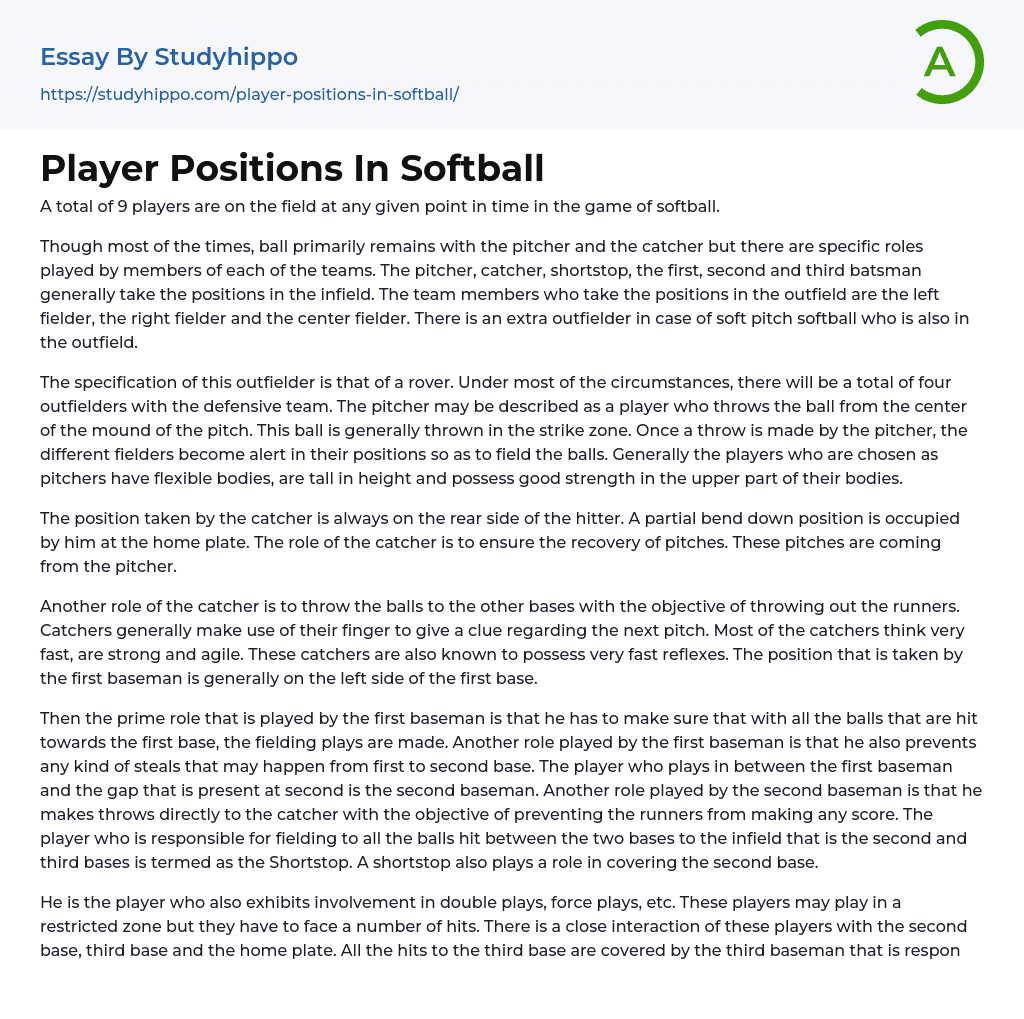A softball team typically consists of 9 players who play on the field during games.
During a game, every team member has a designated responsibility, with the pitcher and catcher usually handling the ball. The infield consists of six players: the pitcher, catcher, shortstop, first baseman, second baseman, and third baseman. In contrast, three individuals occupy the outfield positions: left fielder, center fielder and right fielder; nevertheless, in soft pitch softball games an additional outfielder is allowed to participate.
A typical defensive team consists of four outfielders, including a rover, and a pitcher who stands at the center of the mound to throw into the strike zone. Once the pitch is thrown, fielders take up their positions to retrieve any balls hit towards them. Pitchers are usually tall and flexible with good upper body strength.
...The catcher always stands behind the hitter with a partially bent position at the home plate, and their role is to recover pitches thrown by the pitcher.
The catcher has several responsibilities, including throwing balls to other bases to prevent runners from advancing. They often use their fingers to signal the next pitch and must be quick thinkers, strong, and agile with fast reflexes. On the other hand, the first baseman typically positions themselves on the left side of the first base.
The primary function of the first baseman is to ensure that any ball hit towards first base is fielded. Additionally, the first baseman's role involves preventing any potential steals from occurring between first and second base. The second baseman is positioned between the first baseman and the gap present at second base. The second baseman's role involves
making throws directly to the catcher to prevent runners from scoring. The Shortstop is responsible for fielding all balls hit between second and third base in the infield and also plays a role in covering second base.
The player displays involvement in double plays and force plays despite playing in a limited area and facing numerous hits. Close interaction with second base, third base, and home plate is necessary. The third baseman is responsible for receiving balls from the outfield for all hits to third base.
The Outfielders are referred to as the players who cover the grass area behind the infield and usually support the plays done by the infielders.
- Animals essays
- Charles Darwin essays
- Agriculture essays
- Archaeology essays
- Moon essays
- Space Exploration essays
- Sun essays
- Universe essays
- Birds essays
- Horse essays
- Bear essays
- Butterfly essays
- Cat essays
- Dolphin essays
- Monkey essays
- Tiger essays
- Whale essays
- Lion essays
- Elephant essays
- Mythology essays
- Time Travel essays
- Discovery essays
- Thomas Edison essays
- Linguistics essays
- Journal essays
- Chemistry essays
- Biology essays
- Physics essays
- Seismology essays
- Reaction Rate essays
- Roman Numerals essays
- Scientific Method essays
- Mineralogy essays
- Plate Tectonics essays
- Logic essays
- Genetics essays
- Albert einstein essays
- Stars essays
- Venus essays
- Mars essays
- Evolution essays
- Human Evolution essays
- Noam Chomsky essays
- Methodology essays
- Eli Whitney essays
- Fish essays
- Dinosaur essays
- Isaac Newton essays
- Progress essays
- Scientist essays




